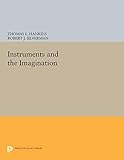Instruments and the Imagination / Thomas L. Hankins, Robert J. Silverman.
Material type: TextSeries: Princeton Legacy Library ; 311Publisher: Princeton, NJ : Princeton University Press, [2014]Copyright date: ©1995Edition: Course BookDescription: 1 online resource (352 p.) : 90 halftonesContent type:
TextSeries: Princeton Legacy Library ; 311Publisher: Princeton, NJ : Princeton University Press, [2014]Copyright date: ©1995Edition: Course BookDescription: 1 online resource (352 p.) : 90 halftonesContent type: - 9780691606453
- 9781400864119
- 502.80940903
- Q185 -- H25 1995eb
- online - DeGruyter
- Issued also in print.
| Item type | Current library | Call number | URL | Status | Notes | Barcode | |
|---|---|---|---|---|---|---|---|
 eBook
eBook
|
Biblioteca "Angelicum" Pont. Univ. S.Tommaso d'Aquino Nuvola online | online - DeGruyter (Browse shelf(Opens below)) | Online access | Not for loan (Accesso limitato) | Accesso per gli utenti autorizzati / Access for authorized users | (dgr)9781400864119 |
Browsing Biblioteca "Angelicum" Pont. Univ. S.Tommaso d'Aquino shelves, Shelving location: Nuvola online Close shelf browser (Hides shelf browser)

|

|

|

|

|

|

|
||
| online - DeGruyter Right Thinking and Sacred Oratory in Counter-Reformation Rome / | online - DeGruyter The Private Science of Louis Pasteur / | online - DeGruyter Classifying by Race / | online - DeGruyter Instruments and the Imagination / | online - DeGruyter Force and Geometry in Newton's Principia / | online - DeGruyter Between Muslim and Jew : The Problem of Symbiosis under Early Islam / | online - DeGruyter Consumer Expenditures : New Measures and Old Motives / |
Frontmatter -- CHAPTER ONE. Instruments and Images: Subjects for the Historiography of Science -- CHAPTER TWO. Athanasius Kircher's Sunflower Clock -- CHAPTER THREE. The Magic Lantern and the Art of Demonstration -- CHAPTER FOUR. The Ocular Harpsichord of Louis-Bertrand Castel; or, The Instrument That Wasn't -- CHAPTER FIVE. The Aeolian Harp and the Romantic Quest of Nature -- CHAPTER SIX. Science since Babel: Graphs, Automatic Recording Devices, and the Universal Language of Instruments -- CHAPTER SEVEN. The Giant Eyes of Science: The Stereoscope and Photographic Depiction in the Nineteenth Century -- CHAPTER EIGHT. Vox Mechanica: The History of Speaking Machines -- CHAPTER NINE. Conclusion -- NOTES -- BIBLIOGRAPHY -- INDEX
restricted access online access with authorization star
http://purl.org/coar/access_right/c_16ec
Thomas Hankins and Robert Silverman investigate an array of instruments from the seventeenth through the nineteenth century that seem at first to be marginal to science--magnetic clocks that were said to operate by the movements of sunflower seeds, magic lanterns, ocular harpsichords (machines that played different colored lights in harmonious mixtures), Aeolian harps (a form of wind chime), and other instruments of "natural magic" designed to produce wondrous effects. By looking at these and the first recording instruments, the stereoscope, and speaking machines, the authors show that "scientific instruments" first made their appearance as devices used to evoke wonder in the beholder, as in works of magic and the theater.The authors also demonstrate that these instruments, even though they were often "tricks," were seen by their inventors as more than trickery. In the view of Athanasius Kircher, for instance, the sunflower clock was not merely a hoax, but an effort to demonstrate, however fraudulently, his truly held belief that the ability of a flower to follow the sun was due to the same cosmic magnetic influence as that which moved the planets and caused the rotation of the earth. The marvels revealed in this work raise and answer questions about the connections between natural science and natural magic, the meaning of demonstration, the role of language and the senses in science, and the connections among art, music, literature, and natural science.Originally published in 1995.The Princeton Legacy Library uses the latest print-on-demand technology to again make available previously out-of-print books from the distinguished backlist of Princeton University Press. These editions preserve the original texts of these important books while presenting them in durable paperback and hardcover editions. The goal of the Princeton Legacy Library is to vastly increase access to the rich scholarly heritage found in the thousands of books published by Princeton University Press since its founding in 1905.
Issued also in print.
Mode of access: Internet via World Wide Web.
In English.
Description based on online resource; title from PDF title page (publisher's Web site, viewed 30. Aug 2021)


